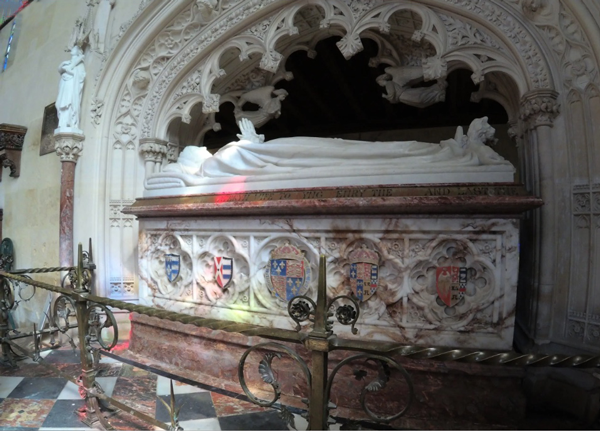SURVIVING HENRY
(This article first appeared in Royals Monthly magazine.)
The beautiful ‘Melton Constable’ or ‘Hastings’ portrait of Catherine Parr
CATHERINE PARR WAS THE LAST of Henry VIII’s six wives, and Queen of England from 1543 to 1547. But most famously, she was the wife who survived.
How do you picture Catherine? Perhaps as a meek, gentle Tudor lady, a nursemaid-companion for the ageing Henry and a loving step-mum to his children, bandaging the suppurating leg of her increasingly bad-tempered husband, breathing soothing words in his ear. After the dramas of Henry’s earlier marriages, does Catherine seem kind of … dull?
Think again. There’s a reason the recent movie about Catherine is called Firebrand. She was in fact a highly intelligent, ambitious, vivacious woman, up there with Anne Boleyn (wife number two) when it came to feistiness and style. She’s the perfect example of a woman who has been defined in terms of her husband, as a history add-on, but who deserves to be remembered in her own right. And she was anything but dull – her life was every bit as dramatic as those of her five predecessors. (And for the record, Catherine wouldn’t have been tending to Henry’s gammy leg – that intimate task was reserved for male physicians.)
So who was Catherine, and what were her achievements? It’s quite a list. She played a significant role in the profound religious changes taking place at the time, and was the first woman in England to have a book published under her own name. She remains England’s most-married queen, having had four husbands, and she was successful in reconciling Henry VIII with his children and re-establishing them in the succession. And, of course, she survived being married to Henry! (But only just …)
Catherine worked hard to maintain good relationships with Henry’s heirs, which was an achievement when you consider that while she was a committed Protestant reformist, her stepdaughter Mary made no secret of her wish for England to return to the Roman Catholic faith. Catherine developed a close relationship with Elizabeth, and watching her step-mother successfully navigate her role as Queen would have played a role in Elizabeth’s later determination to rule England by herself.
Henry VIII highly rated Catherine’s abilities, and made her regent (ruler in his absence) while he was away fighting the French (one last try!). This also meant that if he died, she would rule until Edward came of age. Catherine was Henry’s right-hand man; they were a dream team. Rather more than a nursemaid, then.
Let’s rewind to Catherine’s early life. She was born in 1512 into an aristocratic family, and was married (off) at seventeen. Typically for the time, this was a business arrangement that had nothing to do with love. Her husband died four years later and she remarried, to Lord Latimer, who was nearly twice her age. They were married for nine years and had no children.
The couple attended court, and when Lord Latimer died, Catherine secured an appointment in Princess Mary’s household. This is when things begin to heat up. Catherine fell in love with the glamorous, charismatic Thomas Seymour, brother of Henry VIII’s third wife, Jane. Her mind was made up – this time she would marry for love. But then Catherine caught Henry’s eye, and you did not say no to a proposal from Henry! Aware of Catherine and Thomas’s romance, the king swiftly organised for Catherine’s true love to be posted to Brussels and made her wife number six.
Stoic Catherine stepped up. She probably saw the hand of God in this. It was a calling – her new role would enable her to coax Henry further down the road of religious reform. But perhaps she was forgetting the fate of Anne Boleyn, who had a similar enthusiasm for reform. Catherine took risks – there were banned books in her rooms, and her Protestant zeal made her powerful enemies who attempted to persuade Henry her beliefs were a threat. Plans were drawn up for her arrest. After that dream-team start, Catherine was now in real danger of being sent to the block.
Luckily she got wind of the plot, and threw herself on Henry’s mercy, tearfully pleading for forgiveness: ‘I was just debating religion with you to take your mind off your leg!’ (or words to that effect). She won him round. Catherine was the only one of Henry’s queens who talked her way out of divorce or execution. Survivor indeed.
When Henry died (1547), Thomas returned to court, and six months later the couple married. Catherine was soon pregnant, and this is when things get a little weird.
Thomas was one of those men – wildly ambitious, a charmer, and big trouble. Fourteen-year-old Elizabeth came to live with her step-parents at their Chelsea residence, and Thomas’s behaviour was inappropriate, to say the least. He would enter Elizabeth’s bedroom, tickling her under the covers, even slapping her buttocks. Elizabeth was probably captivated by her glamorous stepfather, may even have had romantic feelings for him. Catherine discovered the pair in an embrace, and having previously dismissed all this as a bit of fun, came to her senses and sent Elizabeth away. It was a lesson for the princess, who would remain wary of ambitious men for the rest of her life.
Catherine and Thomas were reconciled, but tragically Catherine died soon after the birth of her baby, at the age of 36.
Catherine’s tale is, in its way, as sad as those of Henry’s other wives. But we should look to her achievements – the books she wrote, her influence on Elizabeth I, her role in establishing Henry’s children in the succession, thereby ensuring England’s stability. Today, Catherine can still be glimpsed in the Book of Common Prayer – the ‘Prayer for the Monarch’ used in Anglican communities is based on one Catherine Parr wrote for Henry.
Below: Catherine Parr’s marble tomb, at Sudeley Castle in Gloucestershire, where she died of ‘childbed fever’ in 1548


